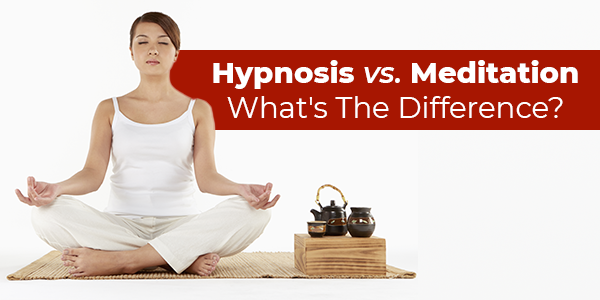Meditation versus Self-Hypnosis

There’s often confusion surrounding meditation and self-hypnosis. Are they just two different terms for the same thing? Or are they completely different?
There’s no cut and dry answer. There are so many types of meditation. Some of them are quite similar to self-hypnosis, while others are certainly not.
Both are impressive tools when used properly and consistently.
What do you think of when you think of meditation? You might have visions of a yogi or monk sitting quietly in solitude.
What comes to mind when you consider self-hypnosis? Maybe you think of a psychologist. Perhaps you remember the stage hypnotist you saw in high school that made some of your fellow students cluck like chickens.
Consider these differences:
1. Purpose:While it is possible to meditate with a very specific end in mind, most forms of meditation have a more general goal. This goal usually revolves around understanding the nature of the mind, mindfulness, and reducing the occurrence and influence of random thoughts.
- Self-hypnosis has a more specific purpose, such as quitting smoking or becoming more confident while public speaking. Self-hypnosis is used as a means of making one more open to suggestions or affirmations.
- Self-hypnosis can also be used to overcome phobias, change your attitude about wealth, or to lose weight.
- Self-hypnosis is often utilized to find a creative solution to a problem. For example, you might want to determine the best plot twist for a novel or find a solution to a complex dilemma in your life.
2. Attention. Meditation focuses on a fixed point or object, such as the breath, a spot on the wall, or a mantra. The goal is to hold your attention on this focal point. When your thoughts stray, and they will, the objective is to return your attention. You learn about how your mind works and how to focus more effectively.
- On the other hand, self-hypnosis frequently involves following a story, such as confidently navigating a social situation. The experience is the object of your focus. You lead yourself through an experience and gain benefits from that.
- With self-hypnosis, you can change your normal perception and perspective. You can experience something that might not be available to you in everyday life.
3. Guided or non-guided. Meditation can be done with oneself or guided. By definition, self-hypnosis is non-guided. However, many people consider the use of hypnosis audio recordings to be self-hypnosis. The use of a live hypnotherapist would not be self-hypnosis.
- There are many audio programs available to help you learn how to meditate or utilize self-hypnosis. The quality of these recordings varies tremendously, as there are numerous amateur practitioners putting their ideas out into the world.
Both meditation and self-hypnosis can bring you benefits, and you can use both in your life.
Meditation can be used to quiet your mind, enhance your ability to focus, and decrease the tendency to ruminate. Meditation has been around for thousands of years and is very effective.
Self-hypnosis is a more surgical tool for dealing with the challenges in your life. Whether you want to increase your confidence, lose weight, quit smoking, or get over your fear of heights, self-hypnosis can be a powerful tool.
Both techniques can work very quickly in some people, but others find that weeks or months are required to see real benefits. If either one might be of benefit to you, why not give it a try for a few months? Measure your results and proceed appropriately.
Self-hypnosis and meditation are not considered to be the same thing but are certainly related. Remember, there are many types of meditation, and some are more similar to self-hypnosis than other types of meditation.
CLICK HERE to Explore Our Free Online Courses


Responses